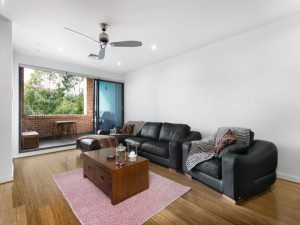Yesterday proved to be interesting for a client of ours. Amy bid at auction on a beautifully converted two bedroom, two bathroom warehouse apartment with enclosed balcony in Kensington.
 Just 3km from CBD and conveniently located near shops, station and arterials were just some of the draw-cards for our buyer, and the secure block, car space on title and separate storage unit on offer delivered just about every criteria she had nominated. In a market where the last twelve month’s growth for units in the suburb has eclipsed six per cent, our findings once we embarked on our research were to come as a bit of a surprise.
Just 3km from CBD and conveniently located near shops, station and arterials were just some of the draw-cards for our buyer, and the secure block, car space on title and separate storage unit on offer delivered just about every criteria she had nominated. In a market where the last twelve month’s growth for units in the suburb has eclipsed six per cent, our findings once we embarked on our research were to come as a bit of a surprise.
The last owners paid $655,000 back in 2010 when the original warehouse block was initially stripped, rebuilt and released by a developer. At the time, all of the other sales in the block were quite comparable. Sales results were all quite consistent, with two bedroom sales sitting between $650K to $720K.
So why did our comparable sales analysis indicate that a lesser figure, some six years later would likely result?
The obvious consideration is that perhaps the vendor overpaid at the time, but in fact this is not the reason. Comparable sales evidence of all other two bedroom dwellings within the same complex indicated that the problem was consistent for all owners Buyers back in late 2009 and into 2010 presumably bought with enthusiasm, whether the purpose of their purchase was for occupation or for investment.
Nobody ever purchases property and anticipates that over a seven year period they will sustain a capital loss. In fact, a common old property misconception is that property doubles every seven years. Yet in this dynamic, popular and enviable suburb, this unit (and several others in the block which have re-sold since the original development) have transacted at a loss several years later. Why could this be? One theory is that the last market peak was back in 2010. Surely this played a factor, but the Kensington market has not only recovered since then, but has continued to grow significantly beyond the highs of the last market peak.
One other important factor played a significant part in the negative capital growth that this apartment sustained.
The development would have sparked interest back in 2009 when available ‘warehouse conversions’ were on offer to the public. Quality finishes, generous spaces, great fixtures and fittings, and a high depreciation schedule would have enticed many buyers to consider opting in. Many investors get excited about new developments and refurbishments, particularly when the promise of hefty tax deductions through depreciation are on offer. We often have clients coming to us with clear instruction from their accountant to pursue a new property for tax saving reasons.
This strategy can present as a serious roadblock to immediate capital growth though.
When the value of the dwelling and improvements is greater than the land component*, the impact can be more costly than the short term tax savings. In the case of an apartment block like this, it is more difficult to exactly determine the land ownership percentage which could be allocated to one particular owner. Common areas in strata developments are often considered as “undivided and equally shared” among residents, but for the purposes of calculating the ‘relative share’ of the land value, varying bedrooms and sized apartments may be determined to have unequal ownership of the land. It varies between complexes. What is important to note though, is that the relative land ownership per resident back in 2009 in terms of land value would have been distinctly lower than the value of their dwelling. After all, the brand new fittings and fixtures, quality build and exciting interiors had zero depreciation. They were brand new.
Just like driving a car with 0km on the odometer out of the lot.
From the moment of settlement, the calculated rate of depreciation would have been quite high and any investors in the block would have presumably had some decent tax savings. But as we know with depreciation, it is an inverse-compounding situation. As the years go by, the tax write-downs diminish year on year until one day, they are negligible. What investors often forget though is depreciation means losing value. It is only acceptable for a dwelling to lose value if the land it sits on is growing at a strong rate; strong enough to offset the rate of the depreciation.
Sadly in the case of this property, the first five years’ of ownership saw the property diminish in value while depreciation was running high.
With the slowdown in the rate of this dwelling depreciation though, and with ever-popular Kensington’s land value increases of late, original owners in the block can likely expect that their asset will have just started to turn the corner in terms of capital growth.
For our buyer who secured the property for $631,000 under auction competition with Amy’s tenacious bidding, her timing of ownership probably couldn’t be better. Her property is still glossy and fabulous, but the key for her is that her Land to Asset Ratio is now a lot more healthy than what it was six years ago when the fit out was new and the land was cheaper.
Land to Asset Ratio underpins so much of our decision-making as Advocates and Investment Property Advisors, and it’s always disappointing to see situations like this where vendors could have invested their savings differently at the time, but instead have sustained a market loss. We are often asked why new and off-the-plan investments decline in value in the early years…. and low Land to Asset Ratio is one key reason.
My most valuable tip I can share on this matter is for investors to always aim for a Land to Asset Ratio of greater than 50%.
